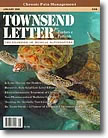The Influence of Caffeine on Pain
The primary application of caffeine supplementation in pain control
has been as an analgesic adjuvant when combined with certain analgesic
drugs. This practice is supported by a number of double-blind studies.
One of these studies found the potentiating action of caffeine on
acetaminophen-induced pain relief to be similar to that experienced
when an analgesic with a peripheral action (such as acetaminophen)
is combined with another with a central action, in this case dextroproxyphen.
By combining the peripherally-acting analgesic with caffeine instead
of a centrally-acting analgesic, the side effects of central analgesics
(such as drowsiness, constipation and nausea) can be avoided.1
In a review of 30 clinical trials involving over 10,000 patients, the
authors concluded that 40% higher dosages of aspirin, acetaminophen
or salicylamide would be needed if they were not given in combination
with a small dose of caffeine.2 A similar adjuvant effect was found
when caffeine was added to propyphenazone,3 or to ibuprofen, a non-steroidal
anti-inflammatory drug.4 However, two recent meta-analyses of randomized
controlled trials have questioned the efficacy of caffeine as an adjuvant
as they found that caffeine added little to the analgesic effect of
acetaminophen,5 and was ineffective in enhancing the analgesic effect
of aspirin.6
Studies have also investigated the efficacy of caffeine intake by itself,
in treating acute pain. In a double-blind crossover study of 53 patients
with non-migrainous headaches, subjects received 2 doses of caffeine,
acetaminophen, 2 combinations of caffeine with acetaminophen, and placebo.
Caffeine appeared to have an independent analgesic effect that remained
significant when statistical adjustments were made for prior caffeine
consumption and caffeine's effects on mood. Sixty-five milligrams
of caffeine was just as effective as 648 milligrams of acetaminophen
in relieving non-migrainous headache symptoms.7
However, when data on 131 patients with chronic back pain were reviewed,
there were no significant differences between low, moderate and high
caffeine users on subjective measures of pain severity or affective
distress,8 suggesting that chronic caffeine intake may be ineffective
as a pain reliever.
Laboratory studies have investigated the mechanism by which caffeine
may reduce pain. In vitro, instant coffee powders were shown to compete
with naloxone for binding to opiate receptors.9 This finding was not
confirmed in vivo, however, as an animal study found that high doses
of coffee, whether or not they contained caffeine, failed to show opiate-antagonizing
activity.10 More recent animal work has provided evidence suggesting
that the antinociceptive effect of caffeine is mediated instead by
central amplification of cholinergic transmission.11 Moreover, adenosine
is suspected to be the metabolite responsible for ischemic muscle pain,
and caffeine is an adenosine receptor antagonist.12
A Warning
Caffeine can also have negative effects
on pain. Acute caffeine withdrawal can cause distress due to "somatic dysfunction." (A term
common to osteopathic physicians, somatic dysfunction refers to "impaired
or altered function of related components of the somatic (body framework)
system: skeletal, arthrodial, and myofascial structures, and related
vascular, lymphatic and neural elements."13) Subjects in one
study regularly consumed 300 mg or more of caffeine a day (found
in about 2 eight-ounce cups of coffee or 6 eight-ounce cups of tea)
and then abstained from caffeine for 4 days. The number of somatic
dysfunctions were found to increase significantly during caffeine
withdrawal. Even by day 4, most of the subjects had not fully returned
to baseline.14
Also, a double-blind crossover study has found that caffeine ingestion
may reduce the effectiveness of transcutaneous electrical nerve stimulation
(TENS).15 This finding suggests that patients trying TENS should avoid
caffeine for a few days prior to the trial.

References
1. Kuntz D, Brossel R. [Analgesic effect
and clinical tolerability of the combination of paracetamol 500 mg
and caffeine 50 mg versus
paracetamol 400 mg and dextropropoxyphene 30 mg in back pain.] Presse
Med 25(25):1171–4, 1996 (in French)
2. Laska EM et al. Caffeine as an analgesic adjuvant. JAMA 251(13):1711–18,
1984
3. Kraetsch HG et al. Analgesic effects of propyphenazone in comparison
to its combination with caffeine. Eur J Clin Pharmacol 49(5):377–82,
1996
4. Forbes JA et al. Effect of caffeine on ibuprofen analgesia in postoperative
oral surgery pain. Clin Pharmacol Ther 49(6):674–84, 1991
5. Zhang WY, Li Wan Po A. Analgesic efficacy of paracetamol and its
combination with codeine and caffeine in surgical pain—a meta-analysis.
J Clin Pharm Ther 21(4):261–82, 1996
6. Zhang WY, Po AL. Do codeine and caffeine enhance the analgesic effect
of aspirin?—A systematic overview. J Clin Pharm Ther 22(2):79–97,
1997
7. Ward N, Whitney C, Avery D, Dunner D. The analgesic effects of caffeine
in headache. Pain 44(2):151–5, 1991
8. Currie SR et al. Caffeine and chronic low back pain. Clin
J Pain 11(3):214–19, 1995
9. Boublik JH et al. Coffee contains potent receptor binding activity.
Nature 301:246–8, 1983
10. Strubelt O et al. Failure of coffee to inhibit the pharmacodynamic
activity of morphine in vivo. Experientia 42(1):35–7, 1986
11. Ghelardini C et al. Caffeine induces central cholinergic analgesia.
Naunyn Schmiedebergs Arch Pharmacol 356(5):590–5, 1997
12. Myers DE et al. Hypoalgesic effect of caffeine in experimental
ischemic muscle contraction pain. Headache 37(10):654–8, 1997
13. Glossary of Osteopathic Terminology.
Glossary Review Committee, Educational Council on Osteopathic Principles
of the American Association
of Colleges of Osteopathic Medicine. Revised April 2002
14. Reeves RR et al. Somatic dysfunction increase during caffeine withdrawal.
J Am Osteopath Assoc 97(8):454–6, 1997
15. Marchand S et al. Effects of caffeine on analgesia from transcutaneous
electrical nerve stimulation. Letter. N Engl J Med 333(5):325–6,
1995

More information on the influence
of nutrition on pain associated with a variety of illnesses can be
found in the second edition of Dr.
Werbach's classic SourceBook, Nutritional Influences on Illness—and
in his updated and expanded CD-ROM with the same title. A free brochure
on his books is available from Third Line Press Inc., 4751 Viviana
Drive, Tarzana, California 91356, USA. (Phone: 800–916–0076;
818–996–0076; Fax: 818–774–1575; e-mail: tlp@third-line.com;
Internet: www.third-line.com.)
|




